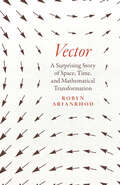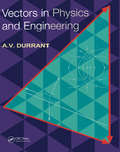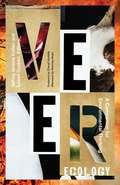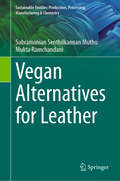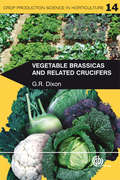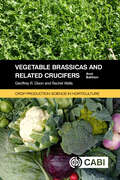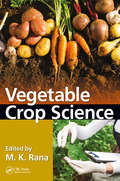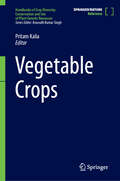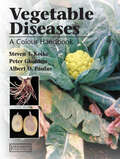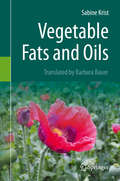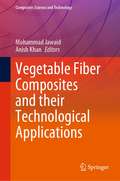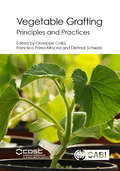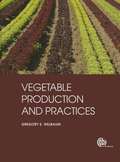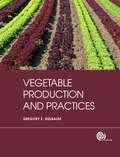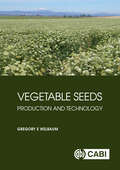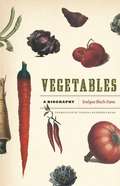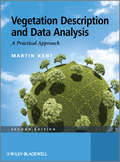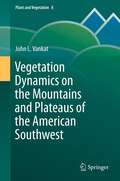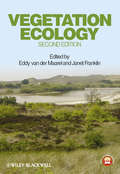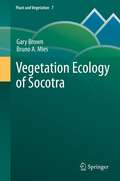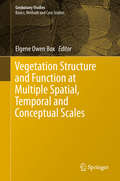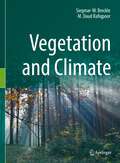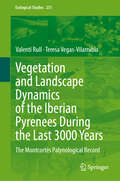- Table View
- List View
Vector: A Surprising Story of Space, Time, and Mathematical Transformation
by Robyn ArianrhodA celebration of the seemingly simple idea that allowed us to imagine the world in new dimensions—sparking both controversy and discovery. The stars of this book, vectors and tensors, are unlikely celebrities. If you ever took a physics course, the word “vector” might remind you of the mathematics needed to determine forces on an amusement park ride, a turbine, or a projectile. You might also remember that a vector is a quantity that has magnitude and (this is the key) direction. In fact, vectors are examples of tensors, which can represent even more data. It sounds simple enough—and yet, as award-winning science writer Robyn Arianrhod shows in this riveting story, the idea of a single symbol expressing more than one thing at once was millennia in the making. And without that idea, we wouldn’t have such a deep understanding of our world. Vector and tensor calculus offers an elegant language for expressing the way things behave in space and time, and Arianrhod shows how this enabled physicists and mathematicians to think in a brand-new way. These include James Clerk Maxwell when he ushered in the wireless electromagnetic age; Einstein when he predicted the curving of space-time and the existence of gravitational waves; Paul Dirac, when he created quantum field theory; and Emmy Noether, when she connected mathematical symmetry and the conservation of energy. For it turned out that it’s not just physical quantities and dimensions that vectors and tensors can represent, but other dimensions and other kinds of information, too. This is why physicists and mathematicians can speak of four-dimensional space-time and other higher-dimensional “spaces,” and why you’re likely relying on vectors or tensors whenever you use digital applications such as search engines, GPS, or your mobile phone. In exploring the evolution of vectors and tensors—and introducing the fascinating people who gave them to us—Arianrhod takes readers on an extraordinary, five-thousand-year journey through the human imagination. She shows the genius required to reimagine the world—and how a clever mathematical construct can dramatically change discovery’s direction.
Vectors in Physics and Engineering
by Alan DurrantThis text is an introduction to the use of vectors in a wide range of undergraduate disciplines. It is written specifically to match the level of experience and mathematical qualifications of students entering undergraduate and Higher National programmes and it assumes only a minimum of mathematical background on the part of the reader. Basic mathematics underlying the use of vectors is covered, and the text goes from fundamental concepts up to the level of first-year examination questions in engineering and physics. The material treated includes electromagnetic waves, alternating current, rotating fields, mechanisms, simple harmonic motion and vibrating systems. There are examples and exercises and the book contains many clear diagrams to complement the text. The provision of examples allows the student to become proficient in problem solving and the application of the material to a range of applications from science and engineering demonstrates the versatility of vector algebra as an analytical tool.
Veer Ecology: A Companion for Environmental Thinking
by Jeffrey Jerome Cohen Lowell DuckertThe words most commonly associated with the environmental movement—save, recycle, reuse, protect, regulate, restore—describe what we can do to help the environment, but few suggest how we might transform ourselves to better navigate the sudden turns of the late Anthropocene. Which words can help us to veer conceptually along with drastic environmental flux? Jeffrey Jerome Cohen and Lowell Duckert asked thirty brilliant thinkers to each propose one verb that stresses the forceful potential of inquiry, weather, biomes, apprehensions, and desires to swerve and sheer. Each term is accompanied by a concise essay contextualizing its meaning in times of resource depletion, environmental degradation, and global climate change.Some verbs are closely tied to natural processes: compost, saturate, seep, rain, shade, sediment, vegetate, environ. Many are vaguely unsettling: drown, unmoor, obsolesce, power down, haunt. Others are enigmatic or counterintuitive: curl, globalize, commodify, ape, whirl. And while several verbs pertain to human affect and action—love, represent, behold, wait, try, attune, play, remember, decorate, tend, hope—a primary goal of Veer Ecology is to decenter the human. Indeed, each of the essays speaks to a heightened sense of possibility, awakening our imaginations and inviting us to think the world anew from radically different perspectives. A groundbreaking guide for the twenty-first century, Veer Ecology foregrounds the risks and potentialities of living on—and with—an alarmingly dynamic planet.Contributors: Stacy Alaimo, U of Texas at Arlington; Joseph Campana, Rice U; Holly Dugan, George Washington U; Lara Farina, West Virginia U; Cheryll Glotfelty, U of Nevada, Reno; Anne F. Harris, DePauw U; Tim Ingold, U of Aberdeen; Serenella Iovino, U of Turin; Stephanie LeMenager, U of Oregon; Scott Maisano, U of Massachusetts, Boston; Tobias Menely, U of California, Davis; Steve Mentz, St. John&’s U; J. Allan Mitchell, U of Victoria; Timothy Morton, Rice U; Vin Nardizzi, U of British Columbia; Laura Ogden, Dartmouth College; Serpil Opperman, Hacettepe U, Ankara; Daniel C. Remein, U of Massachusetts, Boston; Margaret Ronda, U of California, Davis; Nicholas Royle, U of Sussex; Catriona Sandilands, York U; Christopher Schaberg, Loyola U; Rebecca R. Scott, U of Missouri; Theresa Shewry, U of California, Santa Barbara; Mick Smith, Queen&’s U; Jesse Oak Taylor, U of Washington; Brian Thill, Golden West College; Coll Thrush, U of British Columbia, Vancouver; Cord J. Whitaker, Wellesley College; Julian Yates, U of Delaware.
Vegan Alternatives for Leather (Sustainable Textiles: Production, Processing, Manufacturing & Chemistry)
by Subramanian Senthilkannan Muthu Mukta RamchandaniEnvironmental toxicity and sustainability are major areas of research for the leather industry, as well as for the larger luxury and fashion industry. Several alternatives to traditional animal-based leather have been introduced in the market as “vegan” leather, e.g. the pineapple skin leather Piñatex, mycelium (mushroom leather), apple leather, cactus leather, and PU/PVC faux leather. However, a clear assessment of the sustainability (e.g. carbon/water footprint, LCA) for these alternatives is missing. The aim of this book is to provide clarity and a coherent structural assessment of sustainable vegan or vegetarian alternatives of leather. This book contributes to the current research within sustainability and environmental impact, production, and consumption aspects of these materials.
Vegetable Brassicas and Related Crucifers
by Geoffrey DixonThe Brassica crops provide the greatest diversity of products derived from a single genus. As vegetables they deliver leaves, flowers, stems and roots that are used either fresh or in processed forms. This book covers the Occidental crops derived from B. oleracea (cole or cabbage group) and Oriental types from B. rapa (Chinese cabbage and its relatives). Both groups are of immense importance for human nutrition, containing vital vitamins and cancer preventing substances.
Vegetable Brassicas and Related Crucifers (Crop Production Science in Horticulture)
by Geoffrey Dixon Dr Rachel WellsThe Brassica genus contains diverse and economically important species and crops, for example, Brassica oleracea including cauliflower to kohlrabi, B.rapa including pak choi to mizuna, and aquatic crucifers such as watercress. These provide humankind with huge diversities of foods, promoting health and well-being. This substantially expanded second edition reflects the significant advances in knowledge of plant breeding and crop production which have occurred since publication of the original book in 2006. Embracing new Brassicaceae research and concepts of sustainable and automated crop production, topics include: Brassica evolution and transcontinental spread as the basis for crop breeding Gene-editing, rapid sequencing, genetic markers and linkage mapping to enable efficient plant breeding Seed development, F1 cultivars and rapid maturing crops for profitable cropping Environmental impacts on pests, pathogens, crop reliability and quality Soil health and fertility as agronomic principles Environmental sustainability, biocontrol and integrated pest management Vegetable brassicas as nutrient-rich foods for optimal health benefits An invaluable resource for all those involved in Brassica production, this is essential reading for researchers and students in horticulture and plant science, growers, producers, consultants and industry advisors.
Vegetable Crop Science
by M. K. RanaThis book has been prepared to provide every production aspect of important vegetables along with information regarding origin and distribution, composition and uses, botany, varieties, climatic and soil requirement, cultivation practices, harvesting, post-harvest management, insect-pests and diseases along with their control measures. Its users would find this book very practical for raising vegetable crops profitably.
Vegetable Crops (Handbooks of Crop Diversity: Conservation and Use of Plant Genetic Resources)
by Pritam KaliaThe volume on Vegetable Crops as a part of series entitled “Handbooks of Crop Diversity: Conservation and Use of Genetic Resources” will be a unique resource, first of its kind, which will elaborate on origin, evolution, taxonomy, identification, chemical characterization, and genetic improvement of Vegetable Crop Plants. Vegetable crops are an important group of crops comprising solanaceous vegetables, Cole crops, Cucurbitaceous crops, Bulb crops, Root crops, Tuber crops, legume vegetables, leafy & salad vegetables, Okra etc. There is tremendous diversity within each group of vegetable crops. This genetic diversity is from the point of view of landraces and varieties of vegetable crops species used for food, processing, nutraceuticals, pharmaceuticals, etc. Vegetables being an integral part of human diet being rich source of diverse nutrients such as vitamins, minerals and antioxidants, they play an important role in balancing the diet and tackling malnutrition. Besides, due to their intensive cultivation, they also play an important role in enhancing per unit area production and productivity, cropping intensity enhancing, thereby, the farmers income, especially that of small and marginal farmers, and providing job opportunities. The genetic improvement of vegetable crops facilitate continued breeding of varieties with greater resilience to stresses and productivity is mainly dependent on overall genetic variation found in individuals belonging to the cultivated species and/or ancestral species related to cultivated species of vegetable crops. Since genes of interest can be tapped from plant sources for their introduction through controlled breeding processes for genetic improvement, and incorporating of desirable external and internal quality traits, therefore accessibility to the information about these plant genetic resources is key to the success of the breeding efforts. Since there is a need of comprehensive information about the genetic resources, therefore it is important to facilitate their conservation and long-term sustainable use in research and improvement. The comprehensive information on the availability of genetic diversity in each vegetable crop species in this volume would facilitate priority conservation in gene banks, research and use in vegetable crop improvement. Realizing the importance of genetic variability in the improvement of vegetable crops from the point of view of biotic and abiotic stress resistance, enhanced micronutrient, climate change, enhanced shelf life, nutraceuticals, bioactive compounds, especially national and international efforts further need to be stepped up for collection, characterization, evaluation, and conservation of vegetable crops genetic resources to facilitate search for new genes, research and their use in vegetable crops improvement. During 21st century, genomics and marker assisted tools have gained importance for hastening the crop improvement programmes by enhancing breeding efficiency. Realizing that population in South Asia and Southeast Asia is facing acute problem of under and malnutrition, the emphasis on dietary diversification with vegetables is therefore being stressed. Besides, to enhance farmers income much emphasis is being laid on development of varieties having diverse maturity, growth habit, resistance to diseases and insect pest to reduce the use pesticides, enhanced nutrients and shelf life. For these traits, we have to look into landraces, and wild relatives for the traits of interest. Therefore, it has been felt to bring out a vegetable volume with additional accessory and supplemental information, analyses and specifically filtered information which can go a long way in promoting research, search for new genes/alleles, revealing the opportunities available for exploitation of PGR in generation of cultivars to meet upcoming challenges of vegetable crop improvement and diversification and requirement of cultivars for processing, nutraceutical and pharma
Vegetable Diseases: A Colour Handbook
by Steven T. Koike Peter Gladders Albert PaulusOur dependence on healthy vegetable crops as a reliable source of food transcends all barriers of nation and culture. Consumers now demand excellent quality from the industry that produces large volumes of high quality vegetables to be sold locally, regionally and shipped internationally. The diseases that affect vegetables compromise such quality
Vegetable Fats and Oils: The Utilisation Of Volatile Compounds In The Characterisation Of Vegetable Oils And Fats And In Reducing The Bacterial Count Of Ambient Air
by Sabine KristThis encyclopedia scientifically describes 121 vegetable oils and fats. In addition to conventional oils, the book also covers lesser-known oils such as Amaranth, Chia, prickly pear, and quinoa. Author pays particular attention to root plants, extraction, and the ingredients included in information nutritionally relevant to fatty acid patterns. Applications in pharmacology, medicine, cosmetics and technology, as well as possible adverse effects, are discussed. The thoroughly researched reference book includes detailed descriptions along with the latest research results and methods.
Vegetable Fiber Composites and their Technological Applications (Composites Science and Technology)
by Mohammad Jawaid Anish KhanThis book explores vegetable fiber composite as an eco-friendly, biodegradable, and sustainable material that has many potential industrial applications. The use of vegetable fiber composite supports the sustainable development goals (SDGs) to utilize more sustainable and greener composite materials, which are also easy to handle and locally easily available with economical production costs. This book presents various types of vegetable fiber composite and its processing methods and treatments to obtain desirable properties for certain applications. The book caters to researchers and students who are working in the field of bio-composites and green materials.
Vegetable Grafting
by Giuseppe Colla Francisco Pérez-Alfocea Dietmar SchwarzThis book provides comprehensive, current scientific and applied practical knowledge on vegetable grafting, a method gaining considerable interest that is used to protect crops from soil-borne diseases, abiotic stress and to enhance growth/yield. Though the benefits of using grafted transplants are now fully recognized worldwide, understanding the rootstock/scion interactions under variable environmental pressures remains vital for grafting-mediated crop improvement. Vegetable Grafting: Principles and Practices covers: #65533; Breeding, signalling, and physiological and molecular mechanisms involved in grafting #65533; Beneficial effects of grafting including reducing disease damage and abiotic stress; #65533; Effects relating to the impact of grafting on fruit quality #65533; Applications and speciality crops. Including high-quality colour images and written by an international team of expert authors, this book provides up-to-date scientific data and is also concerned with translating science to the field. It is an essential resource for researchers, advanced technicians, practitioners and extension workers.
Vegetable Grafting: Principles and Practices
by Pradeep Kumar Alfonso Albacete M A Nawaz Penelope J Bebeli Meni Ben-Hur Zhilong Bie Angeles Calatayud Roni Cohen Sara Cookson J. Anja Dieleman Ian C Dodd Aviv Dombrovsky Menahem Edelstein Pilar Errea Carmina Gisbert Francesco Giuffrida Yuan Huang Jan Janse Eyal Klein Amnon Koren Marios C. Kyriacou Jung-Myung Lee Cherubino Leonardi Frank J. Louws Isabel Mourão Georgia Ntatsi Gölgen B. Oztekin Ivan Paponov Maria Belen Pico Ana Pina Youssef Rouphael Dimitrios Savvas Andrew J Thompson Allessandra Trinchera Jan Henk Venema Halit YetisirThis book provides comprehensive, current scientific and applied practical knowledge on vegetable grafting, a method gaining considerable interest that is used to protect crops from soil-borne diseases, abiotic stress and to enhance growth/yield. Though the benefits of using grafted transplants are now fully recognized worldwide, understanding the rootstock-scion interactions under variable environmental pressures remains vital for grafting-mediated crop improvement. In this book the authors attend to this need and explain the reasons for, and methods and applications of, grafting. Vegetable Grafting: Principles and Practices covers: · rootstock breeding, signalling, and physiological and molecular mechanisms involved in grafting; · beneficial effects of grafting including reducing disease damage and abiotic stress; · side effects relating to the impact of grafting on fruit quality; and · practical applications and speciality crops. Including high-quality colour images and written by an international team of expert authors, this book provides up-to-date scientific data and is also concerned with translating science to the field. It is an essential resource for researchers, advanced technicians, practitioners and extension workers.
Vegetable Production and Practices
by Gregory E WelbaumSuccessful vegetable production in a modern competitive market requires an understanding of many more factors than the biology of crops and the production techniques involved. This major new textbook brings the science and practice of vegetable production right up to date by addressing modern culture techniques and the recent challenges of consumer demand facing producers today. It introduces vegetable production from the perspective of producing high quality produce that satisfies the needs of the modern consumer. Beginning with the basics of how vegetables are grown using high and low input methods, including organic and sustainable production techniques, the book goes on to introduce and discuss many topics covered less comprehensively in older texts, including Good Agricultural Practices to improve quality, reduce biological contamination and secure food safety; water management; cropping systems; plasticulture; protected culture and mineral nutrition. Vegetable Production and Practices also introduces the use of molecular biology for genetic improvement of crops. Issues specific to individual vegetable crops are addressed by family, including their diseases, harvesting, quality attributes and other issues of increasing importance to consumers, including the role of vegetables in human health. Professor Gregory E. Welbaum has a long history of teaching successful courses in horticulture at Virginia Tech and other universities in the US and worldwide. Vegetable Production Practices has been specifically designed to accompany courses in vegetable crop production, so is ideally suited to inspire students in crop and horticultural sciences, as well as provide a useful reference for experienced practitioners. Read a chapter for free.
Vegetable Production and Practices
by Gregory E WelbaumThis comprehensive new textbook takes a scientific approach to explaining the principles of modern conventional and sustainable commercial vegetable production. The book describes the basic botany of vegetables, environmental requirements for successful growth and development, mineral nutrition, field establishment, harvesting methods and post-harvest handling practices. Professor Gregory E. Welbaum is a former commercial vegetable grower whose family farm has been involved in crop production for several generations. He has taught both classroom and online vegetable crop classes at Virginia Tech for over two decades. Vegetable Production and Practices has been specifically designed to accompany courses in vegetable crop production, so is ideally suited to inspire students in crop and horticultural sciences, as well as provide a useful reference for experienced practitioners.
Vegetable Seeds: Production and Technology
by Gregory E WelbaumMost food and fiber crops are produced from seed. This means that the world's population is dependent on annual seed production for its food supply. Vegetable seed production is much different and more challenging than production of grain crops. This book explains the biology and technology behind producing, maintaining, and enhancing the quality of vegetable seeds from breeding through to the marketed product. It begins with six chapters on a broad range of seed-related topics: the importance of seeds, reproductive biology of plants, genetic improvement strategies, quality assurance of seed production, post-harvest seed enhancement, and organic production. The remaining chapters cover seed production in eleven important vegetable families. Each chapter provides a description of the botany, types and cultivars, genetic improvement, pollination, soil fertility management, pest management, crop production, harvesting, post-harvest handling, and seed yields. The aim of this book is to educate how to produce high-quality vegetable seeds. Incorporating both current methodologies and recent research results, it is suitable for students, researchers, and professionals in the seed industry.
Vegetables: A Biography
by Evelyne Bloch-DanoFrom Michael Pollan to locavores, Whole Foods to farmers' markets, today cooks and foodies alike are paying more attention than ever before to the history of the food they bring into their kitchens—and especially to vegetables. Whether it’s an heirloom tomato, curled cabbage, or succulent squash, from a farmers' market or a backyard plot, the humble vegetable offers more than just nutrition—it also represents a link with long tradition of farming and gardening, nurturing and breeding.In this charming new book, those veggies finally get their due. In capsule biographies of eleven different vegetables—artichokes, beans, chard, cabbage, cardoons, carrots, chili peppers, Jerusalem artichokes, peas, pumpkins, and tomatoes—Evelyne Bloch-Dano explores the world of vegetables in all its facets, from science and agriculture to history, culture, and, of course, cooking. From the importance of peppers in early international trade to the most recent findings in genetics, from the cultural cachet of cabbage to Proust’s devotion to beef-and-carrot stew, to the surprising array of vegetables that preceded the pumpkin as the avatar of All Hallow’s Eve, Bloch-Dano takes readers on a dazzling tour of the fascinating stories behind our daily repasts.Spicing her cornucopia with an eye for anecdote and a ready wit, Bloch-Dano has created a feast that’s sure to satisfy gardeners, chefs, and eaters alike.
Vegetation Description and Data Analysis
by Martin KentVegetation Description and Data Analysis: A Practical Approach, Second Edition is a fully revised and up-dated edition of this key text. The book takes account of recent advances in the field whilst retaining the original reader-friendly approach to the coverage of vegetation description and multivariate analysis in the context of vegetation data and plant ecology.Since the publication of the hugely popular first edition there have been significant developments in computer hardware and software, new key journals have been established in the field and scope and application of vegetation description and analysis has become a truly global field. This new edition includes full coverage of new developments and technologies.This contemporary and comprehensive edition of this well-known and respected textbook will prove invaluable to undergraduate and graduate students in biological sciences, environmental science, geography, botany, agriculture, forestry and biological conservation.Fully international approachIncludes illustrative case studies throughoutNow with new material on: the nature of plant communities; transitional areas between plant communities; induction and deduction of plant ecology; diversity indices and dominance diversity curves; multivariate analysis in ecology.Accessible, reader-friendly styleNow with new and improved illustrations
Vegetation Dynamics
by Qiang Yu Derek Eamus Alfredo Huete Eamus, Derek and Huete, Alfredo and Yu, QiangUnderstanding ecosystem structure and function requires familiarity with the techniques, knowledge and concepts of the three disciplines of plant physiology, remote sensing and modelling. This is the first textbook to provide the fundamentals of these three domains in a single volume. It then applies cross-disciplinary insights to multiple case studies in vegetation and landscape science. A key feature of these case studies is an examination of relationships among climate, vegetation structure and vegetation function, to address fundamental research questions. This book is for advanced students and researchers who need to understand and apply knowledge from the disciplines of plant physiology, remote sensing and modelling. It allows readers to integrate and synthesise knowledge to produce a holistic understanding of the structure, function and behaviour of forests, woodlands and grasslands.
Vegetation Dynamics on the Mountains and Plateaus of the American Southwest
by John VankatThe book provides information essential for anyone interested in the ecology of the American Southwest, including land managers, environmental planners, conservationists, ecologists and students. It is unique in its coverage of the hows and whys of dynamics (changes) in the major types of vegetation occurring on southwestern mountains and plateaus. It explains the drivers and processes of change, describes historical changes and provides conceptual models that diagrammatically illustrate past, present, and potential future changes. All major types of vegetation are covered: spruce-fir, mixed conifer, and ponderosa pine forests, pinyon-juniper vegetation, subalpine-montane grassland, and Gambel oak and interior chaparral shrublands. The focus is on vegetation that is relatively undisturbed, i.e., in natural and near-natural condition, and how it responds to natural disturbances such as fire and drought, as well as to anthropogenic disturbances such as fire exclusion and invasive species
Vegetation Ecology
by Janet Franklin Eddy van der MaarelAdditional resources for this book can be found at: www.wiley.com/go/vandermaarelfranklin/vegetationecology. Vegetation Ecology, 2nd Edition is a comprehensive, integrated account of plant communities and their environments. Written by leading experts in their field from four continents, the second edition of this book:covers the composition, structure, ecology, dynamics, diversity, biotic interactions and distribution of plant communities, with an emphasis on functional adaptations; reviews modern developments in vegetation ecology in a historical perspective;presents a coherent view on vegetation ecology while integrating population ecology, dispersal biology, soil biology,ecosystem ecology and global change studies;tackles applied aspects of vegetation ecology, including management of communities and invasive species;includes new chapters addressing the classification and mapping of vegetation, and the significance of plant functional typesVegetation Ecology, 2nd Edition is aimed at advanced undergraduates, graduates and researchers and teachers in plant ecology, geography, forestry and nature conservation. Vegetation Ecology takes an integrated, multidisciplinary approach and will be welcomed as an essential reference for plant ecologists the world over.
Vegetation Ecology of Socotra
by Bruno Mies Gary BrownAlthough the unique flora of the Socotra Archipelago with its high degree of endemism has received much attention recently, little information is available on the vegetation and related ecological aspects. Based on their extensive field experience of the region, the authors have assimilated a vast amount of knowledge to produce this book, which gives a detailed insight into the plant ecology of Socotra, designated as a World Heritage Site by UNESCO in 2008. The book is divided into seven chapters. After a brief introduction and overviews of important abiotic features, various aspects of the vascular flora are presented in Chapter 4, together with accounts of the bryophyte and lichen flora. Ecology and adaptive strategies of the plants are dealt with in Chapter 5, and Chapter 6 gives a concise description of the main vegetation units. Finally, important management issues of the vegetation are discussed, an essential topic to ensure preservation of the natural heritage of the archipelago.
Vegetation Structure and Function at Multiple Spatial, Temporal and Conceptual Scales
by Elgene Owen BoxThis commemorative volume of invited papers in vegetation science covers a full range of topics, objectives, methods and applications, including conservation and management tasks. These require study at different temporal and spatial scales, often simultaneously. Methodology is important in science, since it responds to particular questions and raises others. It is also closely related to the scale of investigation. Chapters in this book illustrate this interdependence, even in basic tasks such as vegetation sampling and description, measurements and mapping. Individual chapters present globally applicable systems, regional syntheses and local analyses and applications, plus conceptual methodologies, including currently debated hot topics. Vegetation types treated include tropical rainforests, temperate forests, dry steppes and scrub and local turf, sedge and moss communities. There are also chapters on re-vegetation, woodlot management, ecology of an invasive species, and trajectory planning in conservation. This book will be useful to both students and practitioners, for its reviews and examples and as a potential textbook suitable for graduate-level courses and seminars.
Vegetation and Climate
by Siegmar-W. Breckle M. Daud RafiqpoorVegetation, soil and climate are the most important components of ecological systems. The book represents a compact synthesis of our current knowledge about the ecology of the Earth and is thus the basis for understanding the major interrelationships in a global perspective. In the first part, with a rich endowment of illustrations and photographic material, the well-introduced book deals with the essential processes and operations on the Earth's surface that lead to the formation of the vegetation cover with its distinctive zonation. In the second part, the individual vegetation zones as large-scale ecosystems (i.e. zonobiomes of the biosphere) are consistently described comparatively according to certain criteria. In a short and compact form, the main characteristics and structures as well as examples of ecosystem processes are discussed. The large-scale ecosystems are at the same time the basis and reference system for all anthropogenic changes that have drastically altered the vegetation in the last millennia, but especially in the 20th century.This book is a translation of the original German 1st edition Vegetation und Klima by Siegmar-W. Breckle and M. Daud Rafiqpoor, published by Springer-Verlag GmbH Germany, part of Springer Nature in 2019. The translation was done with the help of artificial intelligence (machine translation by the service DeepL.com). A subsequent human revision was done primarily in terms of content, so that the book will read stylistically differently from a conventional translation. Springer Nature works continuously to further the development of tools for the production of books and on the related technologies to support the authors.
Vegetation and Landscape Dynamics of the Iberian Pyrenees During the Last 3000 Years: The Montcortès Palynological Record (Ecological Studies #251)
by Valentí Rull Teresa Vegas-VilarrúbiaThe high-resolution palynological study of the varved sediments of Lake Montcortès has provided a unique record of the regional vegetation shifts over the last 3000 years and of the natural and anthropogenic drivers of ecological change, unparalleled in the Mediterranean. This book shows in detail how the terrestrial ecosystems of Montcortès have responded to climatic events such as the Medieval Climate Anomaly or the Little Ice Age, as well as to varying intensities of anthropogenic pressure from the Bronze Age to the present. The knowledge gained from this palaeoecological study is useful not only for understanding how the modern landscapes of the Pyrenees were shaped, but also for conserving biodiversity and ecosystems in the face of future environmental changes related to ongoing global change. The book is aimed at researchers, university teachers and advanced graduate students in a wide range of disciplines including ecology, palaeoecology, environmental science, biodiversity, geography, sedimentology, archaeology, anthropology, and biodiversity conservation.
